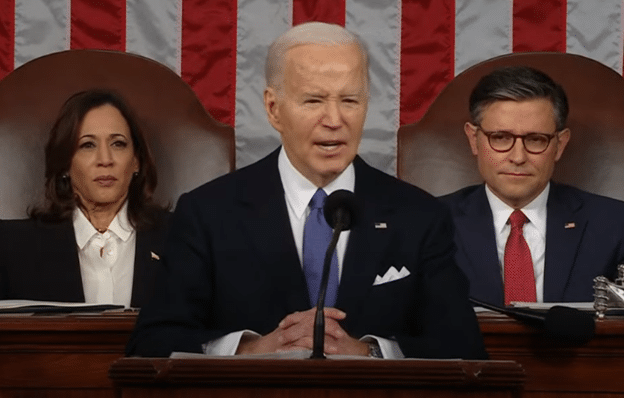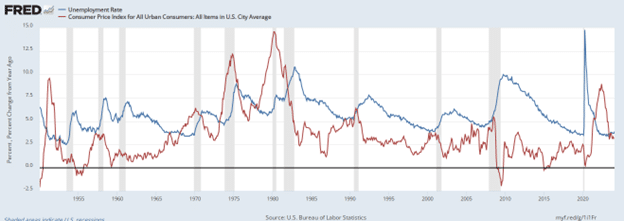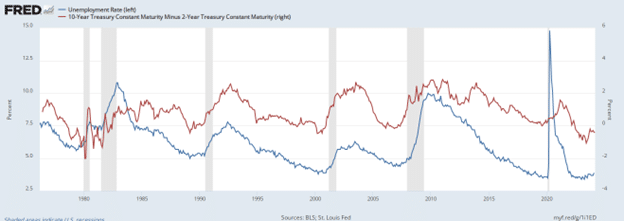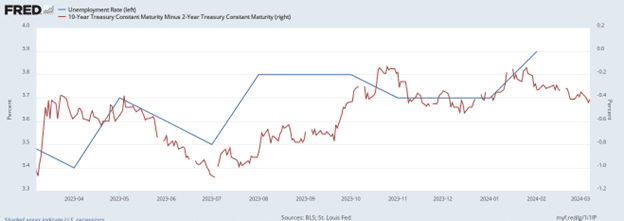March 8, 2024
Permission to republish original opeds and cartoons granted.
Unemployment up 760,000 since Dec. 2022 as unemployment rate jumps to 3.9 percent after Biden promised ‘the landing is and will be soft’

By Robert Romano
Don’t look now, but U.S. labor markets appear to be churning in the wrong direction, as the unemployment rate jumped to 3.9 percent in February, and the unemployment level hit a new high for this cycle at almost 6.5 million, up 760,000 from its low this cycle of 5.7 million in Dec. 2022, according to the latest data from the Bureau of Labor Statistics.
Looking at the overall employment level, that peaked at 161.86 million in Nov. 2023 on a seasonally adjusted basis. Now it’s at 160.96 million in Feb. 2024. That’s 898,000 jobs lost in just three months.
The data mirrors what we see in terms of seasonally adjusted unemployment continued claims, which bottomed at 1.29 million in Sept. 2022 and are now up 610,000 to the current level 1.9 million as Feb. 24.
That has come as inflation has declined from its June 2022 high of 9.1 percent annual rate down to 3.1 percent in Jan. 2024. Prices are still increasing, but not as fast as they were two years ago.
This is the classic inverse relationship: When the economy overheats from inflation, spending slows down, price increases slow down and then unemployment goes up, resulting in an economic slowdown and ultimately a recession as the cycle ends. The same thing is happening now, the question will be how severe the correction will be — and when it will be completed.

In his State of the Union address on March 7, President Joe Biden noted the slowdown in inflation and promised that “The landing is and will be soft.” He might be right. In its Dec. 2023 economic projections, the Federal Reserve stated the unemployment rate would hit 4.1 percent this year.
That’s an implied another 400,000 more unemployed this year, taking the number up to 6.86 million unemployed, with an overall increase 1.16 million in unemployment from the Dec. 2022 low.
And put atop the job losses already seen on the employment level, could mean 1.4 million to 1.5 million lost since peak employment was seen in Nov. 2023, likely by election day, if the Fed’s projections are correct. Now, compared to the last two recessions, which were gargantuan — the financial crisis and Great Recession of 2008 and 2009, and the Covid recession, with 8 million and 25 million of jobs lost, respectively — that would be a much smaller correction.
That would also be smaller than when the dotcom bubble popped in the late 1990s and a recession was experienced in 2001 and 2002. Then, almost 2.1 million jobs were lost from peak employment in March 2001 to the bottom of the labor market in Jan. 2002, from almost 137.8 million down to 135.7 million, although the unemployment rate would not peak until June 2003 at 6.3 percent.
Or it could be worse. At the high end of its projections, the Fed sees unemployment getting as high as 4.5 percent in 2024 and 4.7 percent in 2025. If so, that could mean another 1.1 million jobs lost this year, and a further 300,000 or so in 2025, taking the overall correction up to 2.3 million jobs lost.
That makes recessions and slowdowns, although cyclical, a matter of magnitude — and time. The landing might indeed be soft compared to some other recessions, but you also might not find out about it for another year or two.
A good indicator to watch on that front remains the spread between 10-year and 2-year treasuries. This spread tends to invert prior to recessions, and then uninverts as the unemployment rate rises. At -0.38 percent as of this writing it has not yet uninverted, but is much above its -1.07 and -1.08 percent readings in March and July 2023, respectively.

In that time, unemployment has rising from 3.4 percent in April 2023 to its 3.9 percent level today — like clockwork. Although, looking back on past cycles, the size of either the inversion or uninversion does not appear to matter much, as they simply signal where we are in the cycle.

In this case, it shows that we’re likely past peak employment, or getting past it, right in time for the 2024 election. That seems to show a slowdown or recession on the horizon, the warning signs are there, but it might not officially be reported until after you vote. As usual, stay tuned.
Robert Romano is the Vice President of Public Policy at Americans for Limited Government Foundation.
Calls to End ‘Forever Wars’ Grow as Americans Look to Force Congress to Return to the Constitution

By Bill Wilson
Americans are increasingly unwilling to heed the globalist call to ensnare the U.S. in overseas conflicts that do not benefit Americans, and a growing movement to end unconstitutional acts of war is gaining rapid support across the country.
In Tuesday’s Texas Republican primary, an overwhelming majority of voters sent a strong signal to Washington to end intervention in forever wars by advancing Defend The Guard legislation. Republicans passed a Ballot Proposition that calls on Texas to “prohibit the deployment of the Texas National Guard to a foreign conflict unless Congress first formally declares war.” This is a testament to how strong of a commitment a growing body of conservatives have to demanding Congress acts judiciously before entering foreign wars.
The United States Constitution states that Congress has the sole power to declare war, but globalist warmongers have used loopholes to intervene in foreign conflicts for the duration of modern history, causing immense suffering and financial burden to the American people.
Texas is the latest in a series of states to advance legislation intended to force Congress to abide by the Constitution’s original intent and declare war before entering foreign conflicts. Defend The Guard legislation is advancing in other states, including recent moves in the New Hampshire House of Representatives and the Arizona State Senate. In addition, veteran groups like the American Legion Posts, are adopting Defend The Guard positions.
While it is primarily conservative and veteran groups advancing this important legislation, a growing share of the public is weary of the United States continuing to involve ourselves in foreign disputes – particularly the costly Russia-Ukraine conflict.
Americans have a strong appetite for ending U.S. involvement in the Russia-Ukraine conflict that shows no end in sight, with a Gallup poll showing 61% of Americans say there should be an end date for providing aid to Ukraine, while just 37% say there should be no limit.
It is largely Republicans demanding a structured end date, with 84% of Republicans and 63% of Independents compared to 34% of Democrats saying there should be a limit to the length of time the U.S. provides support to Kiev.
An earlier poll from the New York Times/Siena College found GOP voters oppose continuing to provide Ukraine with aid by an eight-point margin, 52% to 44%, and younger voters, those without a college education, and minorities feel this way the strongest.
GOP voters under 30 oppose continuing to provide Ukraine with funding by 37 points, 65% to 28%. Millennials between age 30-44 oppose continued intervention by 19 points, 58% to 39%, and Gen X voters between 45-64 oppose intervention by 17 points, 57% to 40%.
Minorities, particularly Hispanics, strongly oppose continuing to provide funding to Ukraine. Hispanics oppose continued intervention by 42 points, 70% to 28. Whites narrowly oppose continuing to intervene by 4 percentage points, 46% to 50%, and Blacks oppose intervention by 24 points, 52% to 28%.
Non-college voters are also highly critical of continuing to involve the U.S. in forever wars, with non-college voters opposing intervention in Ukraine by 18 points, 57% to 39%. College-educated voters favor intervention by 9 points, 53% to 44%.
While the institutional left has been quick to condemn conservative demands to scale back involvement in Ukraine as a “softening stance on Russia”, this is largely missing the point.
Conservatives and advocates of scaling back foreign intervention are demanding Congress follows the Constitution and judiciously attempts to keep the U.S. out of foreign conflicts unless absolutely necessary. Americans are not for the most part “softening” on Russia, but they are reading the Russia-Ukraine conflict as a lost cause which taxpayers cannot continue to sink resources into, particularly when our own border is left neglected. Advancements in legislation that curbs U.S. intervention without a declaration of war puts America First and ensures our Constitution is not bypassed by nefarious interests.
Bill Wilson is the former president of Americans for Limited Government.
To view online: https://dailytorch.com/2024/03/calls-to-end-forever-wars-grow-as-americans-look-to-force-congress-to-return-to-the-constitution/
